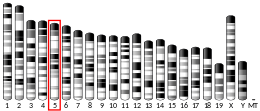UGT2A2
'UDP glucuronosyltransferase 2 family, polypeptide A2, also known as UGT2A2, is an enzyme that in humans is encoded by the UGT2A2 gene.[5][6]
Function
The olfactory neuroepithelium, which lines the posterior nasal cavity, is exposed to a wide range of odorants and airborne toxic compounds. Odorants, which are mostly small lipophilic molecules, enter the mucus flow and reach the odorant receptors on sensory neurons. Odorant sensing is generally a transient process, requiring an effective signal termination, which could be provided by biotransformation of the odorant in the epithelial supporting cells. Xenobiotic-metabolizing enzymes in the olfactory epithelium have been suggested to catalyze inactivation and facilitate elimination of odorants.[5]
References
- GRCh38: Ensembl release 89: ENSG00000271271 - Ensembl, May 2017
- GRCm38: Ensembl release 89: ENSMUSG00000029268 - Ensembl, May 2017
- "Human PubMed Reference:". National Center for Biotechnology Information, U.S. National Library of Medicine.
- "Mouse PubMed Reference:". National Center for Biotechnology Information, U.S. National Library of Medicine.
- "Entrez Gene: UDP glucuronosyltransferase 2 family, polypeptide A2".
- Mackenzie PI, Bock KW, Burchell B, Guillemette C, Ikushiro S, Iyanagi T, Miners JO, Owens IS, Nebert DW (October 2005). "Nomenclature update for the mammalian UDP glycosyltransferase (UGT) gene superfamily". Pharmacogenet. Genomics. 15 (10): 677–85. doi:10.1097/01.fpc.0000173483.13689.56. PMID 16141793.
This article incorporates text from the United States National Library of Medicine, which is in the public domain.



